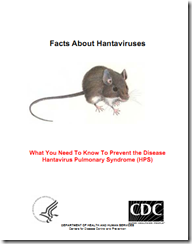Credit CDC
# 8816
Two weeks ago, in Hantaviruses: Of Mice And Men, we looked at a recent Hantavirus fatality in Saskatchewan, and reviewed some of the history of the these rare – but often fatal – rodent borne diseases. You may recall that in the fall of 2012, we followed an outbreak at Yosemite National Park (see MMWR: Yosemite Hantavirus) which resulted in 10 infections, and 3 deaths.
Hantavirus infections (aka HPS or Hantavirus Pulmonary Syndrome) in the United States are most common west of the Mississippi.
While admittedly rare, each year the US sees between 20 and 50 cases, of which more than 1/3rd usually prove fatal.
Credit CDC
Yesterday, in response to two recent Hantavirus cases in Texas, the Texas Department of State Health Services released the following statement:
New Hantavirus Cases Trigger Precaution Reminder
News Release
July 8, 2014
Two recent cases of hantavirus pulmonary syndrome were confirmed in residents of the Texas Panhandle and South Plains, bringing the year’s total to three.
Texas had one case in 2013. No cases were reported from 2009 to 2012.
The disease is severe and sometimes fatal, prompting the Texas Department of State Health Services to remind people to protect themselves from the virus that causes HPS. A case confirmed earlier this year was a resident of the Panhandle.
Hantavirus is carried by certain species of rats and mice that shed the virus in their urine, droppings and saliva. The virus can be transmitted to people when nesting materials or dust contaminated by infected rat or mouse urine, droppings and saliva are stirred up, allowing the virus to be breathed in by humans. The illness is rare, but HPS cases are frequently associated with spring cleaning.
DSHS recommends general safety precautions that apply to Hantavirus as well as other infectious diseases:
- Seal openings that may allow rats and mice to enter homes and workplaces.
- Remove brush, woodpiles, trash and other items that may attract rats and mice.
- Tightly close garbage cans, pet food containers and other food sources.
- Before cleaning up nests or droppings found inside, open windows and doors to ventilate the area for at least 30 minutes.
- If any dust will be stirred up, goggles and a HEPA or N-95 mask are recommended.
- Wear protective gloves to handle dead mice and rats or to clean up nesting areas, urine or droppings.
- Do not stir up dust by sweeping or vacuuming. Dampen areas before cleanup with either a 1-to-10 bleach-water mixture or another effective disinfectant, in order to eliminate dust and begin inactivating the virus. After 30 minutes, apply the viricide again and immediately begin the cleaning process.
- Use the same viricide and apply to dead rodents, nests, urine and droppings before cleaning, with the same 30 minute interval and reapplication process.
Early symptoms of hantavirus infection include fatigue, fever and muscle aches. These symptoms may be accompanied by headaches, dizziness, chills, nausea, vomiting, diarrhea and abdominal pain. Later symptoms include coughing and shortness of breath. If hantavirus is suspected, people should contact their health care provider immediately and inform the practitioner of exposure to rodents, their waste, or their nesting material.
A total of 41 HPS cases have been confirmed in Texas since 1993, the first year it was reported. 14 of those cases resulted in death.
For more information on how you can prevent rodent infestations, the following information is available on the CDC Rodents site. And for more information, the CDC offers a 16 page PDF on Hantavirus, which is available on their Hantavirus Main page.


